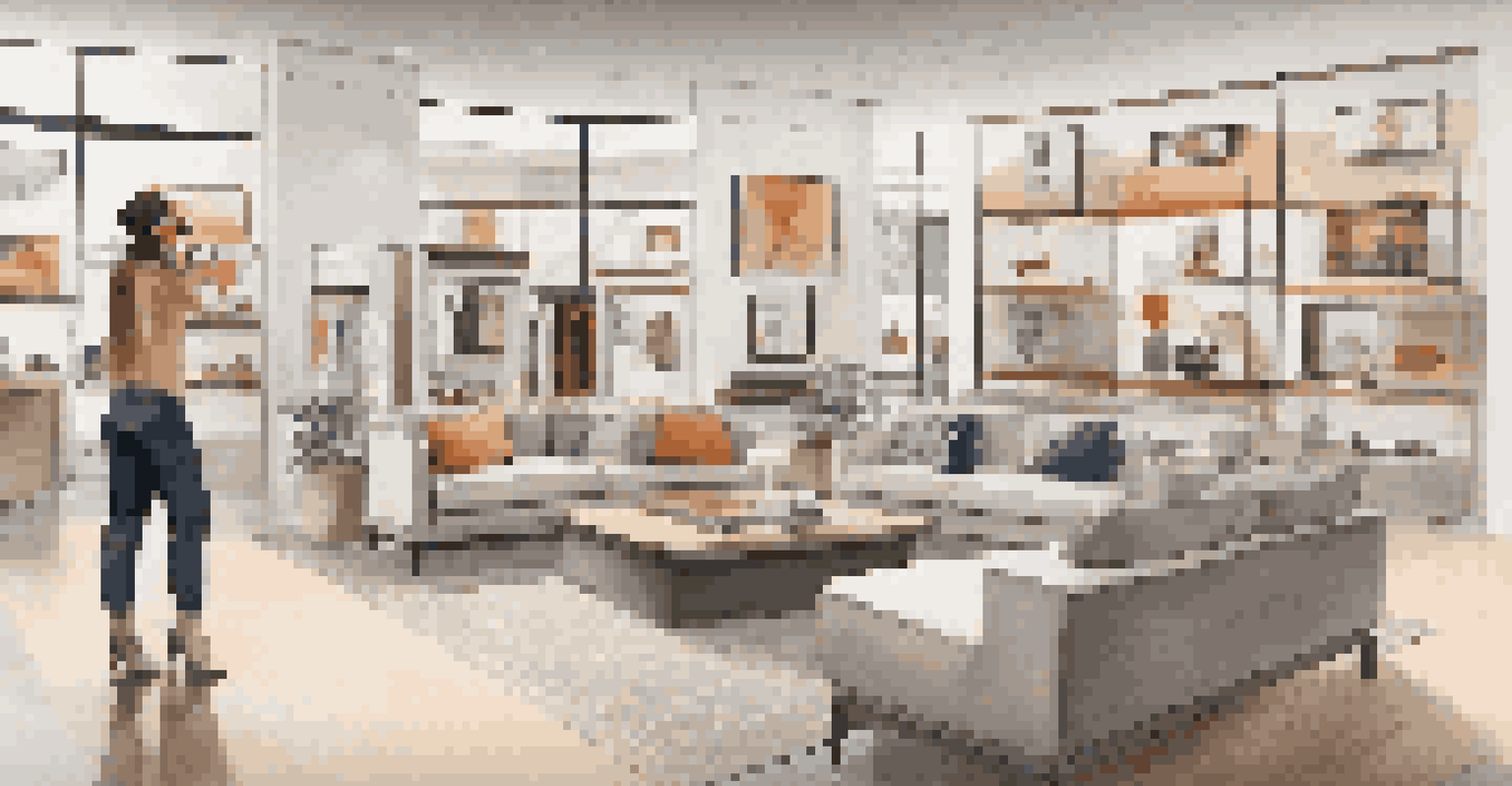Augmented Reality for Personal Shopping Assistants

Understanding Augmented Reality in Shopping
Augmented reality, or AR, blends digital elements with the real world, creating immersive experiences. In personal shopping, this means customers can visualize products in their own space before making a purchase. For instance, imagine trying on a pair of shoes virtually, right from your living room. This technology not only enhances the shopping experience but also helps in making informed decisions.
Virtual reality is a new technology that can be used to enrich the shopping experience and create a more interactive environment for consumers.
With AR, retailers can offer interactive catalogs that allow users to see how furniture looks in their homes or how clothes fit on their bodies. By overlaying digital images onto physical surroundings, AR makes shopping more engaging and personalized. This seamless integration of the digital and physical worlds is changing how consumers approach shopping.
As AR technology continues to evolve, we can expect even more innovative applications in the personal shopping realm. From virtual fitting rooms to interactive product demos, the future looks bright for both consumers and retailers. The key here is that AR isn't just a gimmick; it's a powerful tool that enhances customer satisfaction.
Benefits of AR for Personal Shoppers
One of the biggest advantages of using AR in personal shopping is the convenience it offers. Shoppers can browse, compare, and try out products all from the comfort of their homes. This not only saves time but also minimizes the frustration of returns due to poor fit or wrong choices.

Additionally, AR provides a unique way to visualize products in real life. For example, when shopping for home decor, users can see how a new piece of art would look on their walls without ever leaving their house. This capability helps customers feel more confident in their purchases, leading to higher satisfaction rates.
AR Transforms Shopping Experience
Augmented reality enhances personal shopping by allowing customers to visualize products in their own space, leading to informed purchasing decisions.
Moreover, AR can help retailers reduce the number of returns, which is a significant cost burden for many businesses. When customers can accurately visualize products, they are less likely to change their minds after the purchase. This creates a win-win situation for both shoppers and retailers alike.
How AR Enhances Customer Engagement
AR technology fosters a deeper connection between brands and consumers. By offering interactive experiences, retailers can engage customers in a way that traditional shopping methods simply can't. For instance, virtual try-ons allow customers to experiment with styles, boosting their confidence in their choices.
Augmented reality is the bridge between the digital and physical worlds, allowing consumers to visualize products in their own space before making a purchase.
Furthermore, AR can provide personalized recommendations based on a shopper's preferences and past purchases. Imagine receiving a notification that a new pair of jeans has just arrived, complete with a virtual fitting option. This type of tailored experience keeps customers returning, as they feel valued and understood.
It's important to remember that engagement doesn't stop at the shopping phase. Post-purchase, AR can enhance the customer experience by providing tutorials or styling tips through interactive visuals. This ongoing engagement helps build brand loyalty, as customers feel supported throughout their journey.
Challenges in Implementing AR for Retail
While the benefits of AR are clear, implementing this technology isn't without its challenges. One major hurdle is the cost associated with developing AR applications and integrating them into existing systems. For smaller retailers, this can be a significant investment that may deter them from adopting the technology.
Additionally, there can be a learning curve for both businesses and consumers. Retailers need to ensure their staff is trained to assist customers with AR tools, while shoppers may require guidance on how to use these new features effectively. This gap can hinder the overall experience and acceptance of AR in retail.
Benefits of AR for Retailers
AR technology improves customer engagement and satisfaction, reducing return rates and fostering brand loyalty through interactive experiences.
Finally, not all customers may have access to the necessary devices or high-speed internet required for AR experiences. Ensuring inclusivity is crucial, as businesses don't want to alienate potential customers. Retailers need to consider these challenges while planning their AR strategies to create a seamless shopping experience.
Case Studies: Brands Utilizing AR for Shopping
Several brands have already embraced AR to enhance their shopping experiences, setting examples for others to follow. For instance, IKEA's app allows customers to visualize furniture in their homes before making a purchase. Users can see how a couch would fit in their living room, which streamlines the decision-making process.
Another great example is Sephora, which offers a virtual try-on feature for makeup. Customers can see how different shades of lipstick or eyeshadow look on their own faces using their smartphone cameras. This not only boosts engagement but also helps customers feel more connected to the brand.
These case studies highlight the potential of AR to transform personal shopping, and they show that early adopters can gain a competitive edge. As more brands recognize the value of AR, we can expect a broader shift in the retail landscape toward more interactive and personalized shopping experiences.
The Future of AR in Personal Shopping
As technology continues to advance, the future of AR in personal shopping looks promising. We can expect more sophisticated applications that offer even greater personalization, potentially utilizing AI to analyze customer preferences in real time. This means shopping could become even more tailored to individual needs.
Moreover, as AR hardware becomes more accessible and affordable, more retailers will likely adopt this technology. This wider adoption will lead to innovations in how AR is utilized, from enhancing store layouts to creating immersive shopping experiences that blend online and offline worlds.
Challenges in AR Adoption
While AR offers significant benefits, challenges like high implementation costs and accessibility issues must be addressed for successful adoption.
Ultimately, the future of AR in personal shopping will be about creating seamless experiences that make shopping more enjoyable and efficient. By leveraging this technology, retailers can not only meet the demands of modern consumers but also create memorable shopping experiences that drive loyalty.
Getting Started with AR for Your Business
If you're a retailer looking to integrate AR into your shopping experience, the first step is to assess your current technology. Identify the areas where AR can add value, whether that's through virtual try-ons, interactive product displays, or immersive catalogs. Understanding your customers' needs will help you tailor your AR strategy effectively.
Next, consider partnering with AR developers or agencies that specialize in creating these experiences. Collaborating with experts can streamline the process and ensure that you implement AR solutions that are user-friendly and engaging. This partnership can also help you stay updated on the latest trends and technologies.

Finally, focus on educating your customers about the new features you offer. Clear communication about how to use AR tools can enhance their experience and encourage them to embrace this innovative shopping method. By taking these steps, you can successfully integrate AR into your business and elevate your customers' shopping journeys.